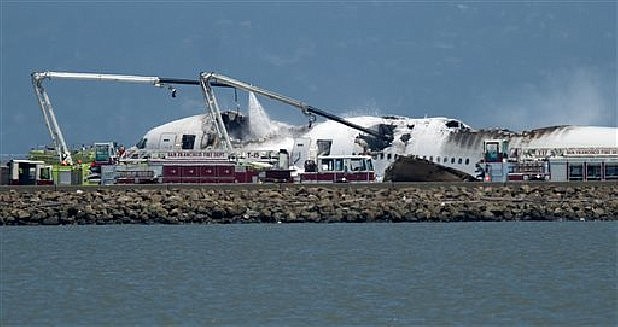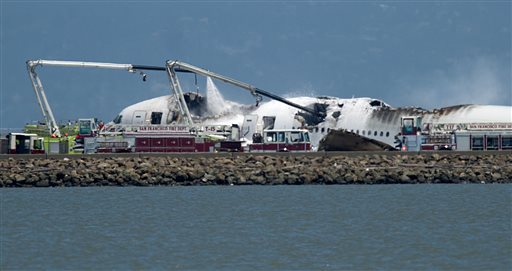Police officers threw utility knives up to crew members inside the burning wreckage of Asiana Airlines Flight 214 so they could cut away passengers' seat belts. Passengers jumped down emergency slides, escaping from thick billowing smoke.
And amid the chaos, some urged fellow passengers to keep calm, even as flames tore through the Boeing 777's fuselage.
As investigators try to determine what caused the crash of Flight 214 that killed two passengers Saturday at San Francisco International Airport, the accident left many wondering how nearly all 307 people aboard were able to make it out alive.
"It's miraculous we survived," said passenger Vedpal Singh, who had a fractured collarbone and whose arm was in a sling.
Investigators took the flight data recorder to Washington, D.C., overnight to begin examining its contents for clues to the last moments of the flight, officials said. They also plan to interview the pilots, the crew and passengers.
"I think we're very thankful that the numbers were not worse when it came to fatalities and injuries," said National Transportation Safety Board chief Deborah Hersman on NBC's "Meet the Press" on Sunday. "It could have been much worse."
Hersman said investigators are looking into what role the shutdown of a key navigational aid may have played in the crash. She said the glide slope - a ground-based aid that helps pilots stay on course while landing - had been shut down since June.
She said pilots were sent a notice warning that the glide slope wasn't available. Hersman told CBS' "Face the Nation" that there were many other navigation tools available to help pilots land. She says investigators will be "taking a look at it all."
Since the crash, clues have emerged in witness accounts of the planes approach and video of the wreckage, leading one aviation expert to say the aircraft may have approached the runway too low and something may have caught the runway lip - a seawall at the foot of the runway.
San Francisco is one of several airports around the country that border bodies of water that have walls at the end of their runways to prevent planes that overrun a runway from ending up in the water.
Since the plane was about to land, its landing gear would have already been down, said Mike Barr, a former military pilot and accident investigator who teaches aviation safety at the University of Southern California.
It's possible the landing gear or the tail of the plane hit the seawall, he said. If that happened, it would effectively slam the plane into the runway.
Noting that some witnesses reported hearing the plane's engines rev up just before the crash, Barr said that would be consistent with a pilot who realized at the last minute that the plane was too low and was increasing power to the engines to try to increase altitude.
Barr said he could think of no reason why a plane would come in to land that low.
"When you heard that explosion, that loud boom and you saw the black smoke ... you just thought, my god, everybody in there is gone," said Ki Siadatan, who lives a few miles away from the airport and watched the plane's "wobbly" and "a little bit out of control" approach from his balcony.
"My initial reaction was I don't see how anyone could have made it," he said.
Inside the plane, Singh, who was sitting in the middle of the aircraft with his family, said there was no forewarning from the pilot or any crew members before the plane touched down hard and he heard a loud sound.
"We knew something was horrible wrong," said a visibly shaken Singh. He said the plane went silent before people tried to get out anyway they could. His 15-year-old son said luggage tumbled from the overhead bins.
Passenger Benjamin Levy said it looked to him that the plane was flying too low and too close to the bay as it approached the runway. Levy, who was sitting in an emergency exit row, said he felt the pilot try to lift the jet up before it crashed.
He said he thought the maneuver might have saved some lives. "Everybody was screaming. I was trying to usher them out," he recalled of the first seconds after the landing. "I said: 'Stay calm, stop screaming, help each other out, don't push.'"
By the time the flames were out, much of the top of the fuselage had burned away. The tail section was gone, with pieces of it scattered across the beginning of the runway. One engine appeared to have broken away.
The flight originated in Shanghai, China, and stopped over in Seoul, South Korea, before making the nearly 11-hour trip to San Francisco, airport officials said. The airline said there were 16 crew members aboard and 291 passengers. Thirty of the passengers were children.
San Francisco Fire Department Chief Joanne Hayes-White said the two who died were found outside of the plane. "Having surveyed that area, we're lucky that there hasn't been a greater loss," she said.
Airport spokesman Doug Yakel said 49 people were critically injured and 132 had less significant injuries.
South Korean government said the passengers included 141 Chinese, 77 South Koreans, 61 Americans, three Canadians, three from India, one Japanese, one Vietnamese and one from France, while the nationalities of the remaining three haven't been confirmed.
Chinese state media identified the dead as two 16-year-old girls from China's eastern Zhejiang province. China Central Television cited a fax from Asiana Airlines to the Jiangshan city government. They were identified as Ye Mengyuan and Wang Linjia.
At least 70 Chinese students and teachers were on the plane heading to summer camps, according to education authorities in China.
Asiana President Yoon Young-doo said at a televised news conference that it will take time to determine the cause of the crash. But when asked about the possibility of engine or mechanical problems, he said he doesn't believe they could have been the cause.
He said the plane was bought in 2006 but didn't provide further details. Asiana officials later said the plane was also built that year.
Yoon also bowed and offered an apology, "I am bowing my head and extending my deep apology" to the passengers, their families and the South Korean people over the crash, he said.
Four pilots were aboard the plane and they rotated on a two-person shift during the flight, according to The Ministry of Land, Infrastructure and Transport in South Korea. The two who piloted the plane at the time of crash were Lee Jeong-min and Lee Gang-guk.
Yoon, the Asiana president, described the pilots as "skilled," saying three had logged more than 10,000 hours each of flight time. He said the fourth had put in almost that much time, but officials later corrected that to say the fourth had logged nearly 5,000 hours. All four are South Koreans.
Asiana is a South Korean airline, second in size to national carrier Korean Air. It has recently tried to expand its presence in the United States, and joined the Star Alliance, which is anchored in the U.S. by United Airlines.
The 777-200 is a long-range plane from Boeing. The twin-engine aircraft is often used for flights from one continent to another because it can travel 12 hours or more without refueling.
The most notable accident involving a 777 occurred on Jan. 17, 2008 at Heathrow Airport in London. British Airways Flight 28 landed hard about 1,000 feet short of the runway and slid onto the start of the runway. The impact broke the 777-200's landing gear. There were 47 injuries, but no fatalities.

